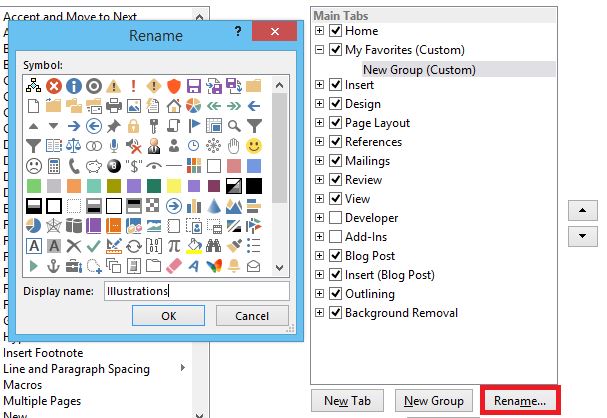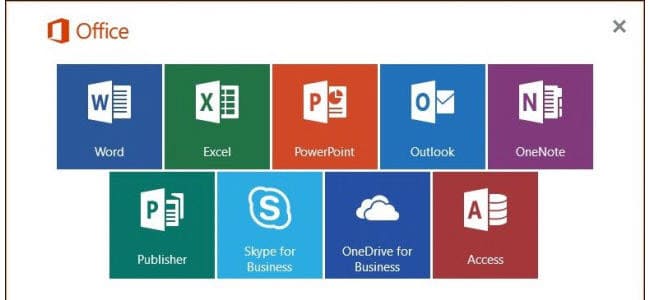-->
The ribbon component of the Microsoft Office Fluent user interface gives users a flexible way to work with Office applications. Ribbon Extensibility (RibbonX) uses a simple, text-based, declarative XML markup to create and customize the ribbon.
The code example in this topic shows how to add custom components to the ribbon for a single document, as opposed to adding application-level customizations. In the following steps, you add a custom tab, a custom group, and a custom button to the existing ribbon in Word. You also implement a callback procedure for the button that inserts a company name into the document.

To include a custom ribbon tab that has a command button to run a macro in your enterprise global template file in Project 2010, follow these steps: Steps to Create a custom macro. Start Project client. Start a new project. It's name is Project1. On the View tab, click the Macros drop down list, and then click RecordMacro. MS Word - Customize RibbonWatch More Videos at: By: Mr. Pavan Lalwani Tutorials Point India Pr. Enable Developer Tab. Open Microsoft Word, then go to the File Tab Options Customize Ribbon check the Developer Tab in the right column Click OK. A developer tab will populate. The Controls section has about eight different options that can be added to your Word document: Rich Text, Plain-Text, Picture, Building Block Gallery.
- Once a custom toolbar has been deleted it cannot be restored. You cannot delete any of the built-in toolbars. There is no way to attach or remove toolbars to documents and templates using VBA. If you want to make changes to an existing Word add-in you must open the add-in file before you start.
- Using Word Options To Customize Quick Access Toolbar In this panel select a command on the left and then click Add to add it to the toolbar. To move the Quick Access toolbar back atop the Ribbon choose the Show Above the Ribbon command. Select Customize Quick Access Toolbar.
Create the customization file in any text editor and save the file with the name customUI.xml.
Add the following XML markup to the file and then close and save the file.
Create a folder on your desktop named customUI and copy the XML customization file to the folder.
Validate the XML markup with a custom schema.
Create a document in Word and save it with the name RibbonSample.docm.
Open the Visual Basic Editor, add the following procedure to the ThisDocument code module, and then close and save the document.
Add a .zip extension to the document file name and then double-click it to open the file.
Add the customization file to the container by dragging the customUI folder from the desktop to the .zip file.
Extract the .rels file to your desktop. A _rels folder that contains the .rels file is copied to your desktop.
Open the .rels file and add the following line between the last Relationship tag and the Relationships tag. This creates a relationship between the document file and the customization file.
Close and save the file.
Add the .rels folder back to the container file by dragging it from the desktop, overwriting the existing file.
Rename the document file to its original name by removing the .zip extension.
Open the document and notice that the ribbon now displays the My Tab tab.
Choose the tab and notice the Sample Group group with a button control.
Choose the button to insert the company name into the document.
See also
Support and feedback
Ms Word 2016 Customize Ribbon
Have questions or feedback about Office VBA or this documentation? Please see Office VBA support and feedback for guidance about the ways you can receive support and provide feedback.
This page last revised: 28 Mar 2021 15:19:03 -0500 .

Microsoft Word Ribbon Design

Customize Ribbon For Microsoft Word
The Ribbon user interface (UI) has its own customizable features - the Ribbon itself and the Quick Access Toolbar (QAT). Of these, only the QAT customizations can be stored in a template using Word itself. See also Modifying the QAT in Microsoft Word
Last modified Friday, January 01, 2021.
Changing the Ribbon
Word 2007 provides no method within Word for changing the Ribbon. Word 2010 and later allow changes to the Ribbon from within Word, but only for the entire program, not storing them within individual templates. For the Ribbon, the easiest entry point for customization within Word is to right-click on the ribbon. (You can also get to these dialogs from the Word Options, but I know of no reason to do so.) Choose modify the ribbon.
Word 2010 and later allow customization through the user interface of Word. However, these modifications are limited and not easily shared. Ribbon changes in Word 2007, and Ribbon modifications that you intend to share in any version of Word are best done using an XML editor. Barcode.dll. See Customize the Ribbon (It doesn't take rocket science) by Greg Maxey as a starting point on how to do this.
The changes made to a Word 2010 ribbon through the interface are stored in the file Word14.CustomUI. Those made to a Word 2013(365) ribbon would be stored in a file named Word15.CustomUI and for Word 2016 in a file named Word16.CustomUI. Again, these are changes made through Word's interface, not by coding the XML directly. If this file is renamed, Word will start without the customizations and will form a new file when any new customizations are made through the interface. This file is for saving customizations, not for sharing, copying or moving them.
This file name changed to Word.OfficeUI some time in 2018 for all versions that have ribbon modifiction through Word itself (Word 2010-2019). In Windows 10, this file will be found in the folder:
Ms Word 2007 Customize Ribbon
Remember, this file is not for exporting or sharing. If you have more than one version of Word that uses this file, they will share. This can cause conflicts.
Exported ribbon files from the Interface (Word 2010-2016) are named Word Customizations.exportedUI. You must use the Word interface to import these as well to export them. Simply renaming them will not work. See this support page for details on the XML structures. Again, importing one of these files overwrites any existing modifications. These export files as well as the native files can be modified using a simple XML editor to provide different icons or labels. See Modify QAT Ribbon Button Icon Text. Much more flexibility is gained by doing full ribbon customization as described in the Rocket Science page.
See Deploying a Customized Ribbon and Quick Access Toolbar in Office 2010 on the Microsoft Office site. Although I do not think distributing the customizations to the Ribbon made in the Interface is a worthwhile way to distribute customizations, Microsoft does provide instructions. Just keep in mind that any customizations distributed this way will overwrite any existing customizations in the Microsoft Ribbon and QAT files.
Custom Images
If you modify the Ribbon using Word itself (the user interface) you are stuck with the images that Word assigns to commands. The one for macros is the same for all macros and not very appealing. These cannot be modified through Word.
Ms Word Customize Ribbon
To use different images as icons you need to go outside of Word and change the XML. Greg Maxey shows how this is done in his pages beginning with Ribbon Images & Labels Part I. You can use Icons from other Office programs or add your own images. Instructions for modifying icons in the ribbon customizations made through Word, itself, are given at the bottom of the page Modify QAT Ribbon Button Icon Text. Here is a downloadable document from Microsoft that gives the names of available icons.
As you may be able to tell, this is a work in progress. As I learn more, I'll share it here, time allowing.
Again, I strongly recommend going to Greg Maxey's page on Customizing the Ribbon. Warriors orochi 2 pc download.